A patent application published on Thursday reveals Apple's interest in a docking solution for iPhone and iPad that supports multiple accessories and incorporates a display, advanced gesture controls, wireless communications and even inductive charging.
Apple has in the past manufactured simple docks for iPhone and iPad, which can perhaps be more accurately described as glorified stands, but the company has not yet released such an accessory for its latest iPhone 6 or iPhone 6 Plus handsets. Today's patent application could be the basis of a more evolved product, one that includes features seen on docking solutions from third-party manufacturers.
As published by the U.S. Patent and Trademark Office, Apple's application for a "Docking station with audio output" details a dock that integrates a display, proximity sensors, a wireless communications package for transferring data and remotely controlling Internet connected devices, touchpad control and more.
In its most basic form, Apple's invention is a basic charging stand that charges an iOS device via a Lightning connector insert. Like the most recent iPhone 5/5s dock, audio is passed through a digital-to-analog converter and sent out through a headphone jack, while a rear connector accepts power from an adapter. Along with the main portable device, however, the dock also supports one or more accessories.
Certain examples allow for an accessory to be powered via wired or inductive charging, while others build in support for data transfer and user control. Although specific accessory hardware goes unspecified, the document language leaves room for a device like Apple Watch to be attached, charged and synced directly from the dock.
Other embodiments add in displays and LED status lights. For example, a built-in display can be used to present a user with data taken off an attached iPhone or iPad, including the time, device mode, weather, news and other information. Alternatively, the dock can pull data from another accessory or a wireless router using onboard communications hardware. Both wired and wireless functions are supported.
Built-in Wi-Fi capabilities can also be used to control connected devices like coffee makers, thermostats, locks, lighting and appliances. Apple is already prepared to tap into this so-called "Internet of Things" with HomeKit, an iOS framework that will let users control compatible connected home devices via Siri.
Apple's imagined dock also includes gesture control, an area in which Apple has shown intense interest as of late. Using proximity sensors, users would be able to a perform range of operations through midair hand gestures, including turning the display on or off, and selecting onboard functions like cycling through news content.
In another embodiment, the invention serves as a docking station with data receptacles covering a gamut of interconnect technologies, such as USB, HDMI, DVI, Thunderbolt and more.
Finally, multicolored LED lights can inform users of a docked device's mode, such as do-not-disturb and airplane mode, as well as charge status and other critical information. In conjunction with proximity sensors, LEDs may also play a convenience role and light up when a user's hand nears portions of the dock, illuminating hard to see buttons and ports.
It is unclear if Apple intends to build its advanced docking station, but with an expanding stable of connected portable devices and the upcoming Apple Watch, such a product would address the needs of a quickly growing market.
Apple's docking station patent application was first filed for in September 2013 and credits Gerhard A. Schneider, Scott Krueger, Robert D. Watson, Alexei Kosut and Tony Chi Want Ng as its inventors.
 Mikey Campbell
Mikey Campbell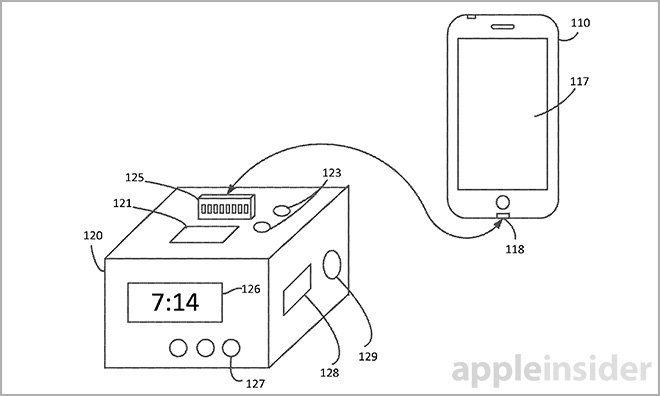
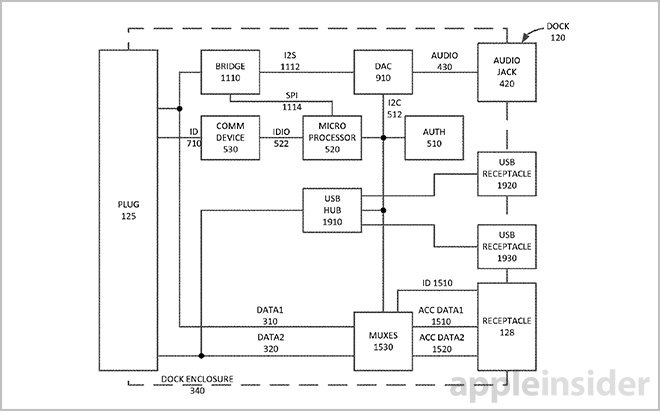








-m.jpg)






 Christine McKee
Christine McKee
 Chip Loder
Chip Loder
 Malcolm Owen
Malcolm Owen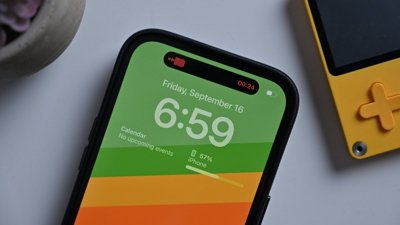
 Marko Zivkovic
Marko Zivkovic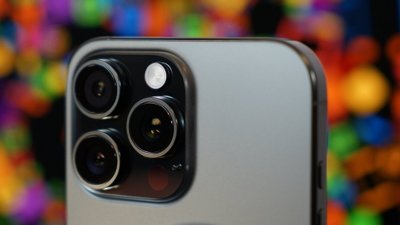
 Wesley Hilliard
Wesley Hilliard
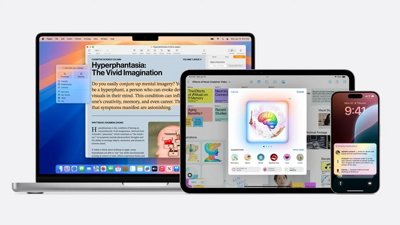






-m.jpg)




15 Comments
Glad to see that Apple haven't given up on the idea of docks.
Agreed. Seriously didn't enjoy getting my dock cut off by Apple.
I use Belkin's lightning dock at home and work and it is down right awesome. But I would like to see Apple come up with a conductive recharging system similar to Mobee's magic mouse recharger, BUT include a spot for the Apple Watch on the same dock. No one wants a dock for each and every device.
This is good news. Apple should never have stopped the dock.
[quote name="GTR" url="/t/185203/apple-investigating-iphone-dock-with-integrated-display-touchpad-sensors-inductive-charging-more#post_2691217"]Agreed. Seriously didn't enjoy getting my dock cut off by Apple.[/quote] That made my eyes water! [SIZE=5]????[/SIZE] Seriously though I am hoping Apple have a small area Wi-Trcity type charge solution for iDevices in the not too distant future. No wires and no induction pads required. A few feet is all that is required so devices may be charged within that area. Most folks I know would simply plonk such a charger in the kitchen. .... And no, people with pacemakers do not need to worry and no Tesla didn't invent the current tuned system (although obviously the broader concept) and yes it works, check out the MIT alumnis' web site. http://witricity.com edit: to to too :no: